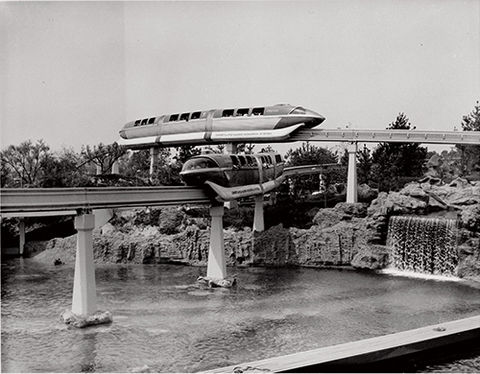
The Disneyland Monorail System is one of many great examples of Walt Disney turning his dreams into reality. As fate would have it, Walt noticed a monorail train on a trip to Germany and immediately envisioned it as the transportation system of the future, and knew he wanted one in his park. With the help of the Alweg company in Germany, this dream came to Disneyland on June 14, 1959. It opened as part of the great 1959 expansion, along with the Submarine Voyage and Matterhorn Bobsleds.
The attraction’s original title was the Disneyland-Alweg Monorail System—Alweg being an abbreviation for Axel Lennart Wenner-Gren, the founder of Alweg. Imagineer and Disney Legends Bob Gurr—best known for designing many Disneyland vehicles—and Roger Broggie—a mechanical engineer with an enthusiasm for railroading—worked together to design the trains. Unlike its predecessor the Viewliner, the Monorail ran above the ground on a beam, giving it the nickname “Highway in the Sky,” an appropriate name for the very first daily operating monorail system in the Western Hemisphere.
Years after Walt’s vision became reality, in December of 1986, the Monorail was honored as a historical mechanical engineering landmark by The American Society of Mechanical Engineers. An official plaque was erected at the Tomorrowland Station and states “the cars are equipped with 600 Volt D.C. 100 HP electric motors driving rubber tired wheels on a single beam trackway”—you can still see the plaque when you visit Disneyland today.
The first Monorail vehicles were known as Mark I models, which had two separate cars with three cabins each plus nose cone and tail cone sections. Each front car had a bubble-like windshield at to give the pilot clear view of the surroundings. The trains were known as Monorail Red and Monorail Blue.

When the Monorail first opened, Tomorrowland station was the only open arrival and departure point. Guests would travel roundtrip around Tomorrowland soaring by the Autopia tracks and the Submarine lagoon, in a just-under-a-mile’s distance loop. These electrically-propelled trains were almost silent as they passed by, which did not distract guests as they roamed the park.
Bob Gurr told a story, featured on our blog, about the Monorail’s opening day in 1959 when Bob was the pilot for the opening ceremony, and then Vice President Richard Nixon was on hand with his wife and two daughters to inaugurate the new attraction. During the rehearsal of the ribbon-cutting ceremony, Walt suggested that Bob give Vice President Nixon a ride. Bob obliged, but as he came back around the circuit he realized that all of the Secret Service agents were still on the platform, meaning he had, in essence, “kidnapped” the Vice President of the United States for a brief time.
In June 1961, the Monorail was improved in several ways. First, the Mark I was replaced by a new model, the Mark II. Each car had four cabins instead of three to accommodate more passengers. There were now three trains: Red and Blue remained with Monorail Gold debuting as the third. An even bigger “bubble” windshield was used on these new trains to give an even better view, while nose and tail cone viewing remained. The Mark II Red and Blue can be seen right here on our Disneyland model. The track was expanded to go outside of Tomorrowland to the Disneyland Hotel and became two and a half miles in length. Instead of just the one station, guests could now board and disembark at the Tomorrowland Station and the Disneyland Hotel Station, which created a whole new way to enter Disneyland.
Situated at the front of the train, Monorail pilots had no need to control turns on the train, but they do control the speed of the train and whether it moves forward or backward, giving two honks of the horn when moving forward and three while going backward. One honk meant an acknowledgement, such as when they honked at their engineer friends on the Disneyland Railroad. When the trains were done for the day, they would be taken to the Monorail Shop above the steam train roundhouse to rest for the night.
The Mark IIs were replaced by the Mark III in 1969, while today the Mark VII (seven) soars above Walt’s original Magic Kingdom. Monorail trains were also installed at Walt Disney World Resort thanks to Walt’s vision of a Monorail system in EPCOT, his Experimental Prototype Community of Tomorrow. At Walt Disney World Resort, rather than serving as an attraction, the Monorail trains are used to transport guests between Resorts and the Parks. Today, we can all appreciate Walt’s admiration for transportation in innovation with the introduction of the Monorail System. Much like many of Walt’s dreams, the Monorail keeps moving forward.
Shawn Carrera
Guest Experience Associate at The Walt Disney Family Museum
